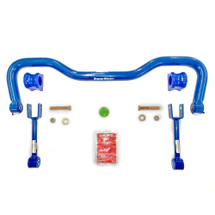
Sprinter 3500 Class C Upgrade Series: Part 2 - Rear Sway Bar
SS110 Rear Sway Bar
Welcome back to our Sprinter 3500 Class C upgrade series. In Part 1 we looked at the SS88-1889 Rear Shock Absorbers and the improvement they made to the "rock and roll" issue common to the Sprinter chassis. Next, we'll be taking a look at the rear anti-sway bar.
An anti-sway bar (or more simply, "sway bar") is a torsional spring which is twisted when a motorhome leans in one direction or another, but freely rotates without being twisted when both sides of the axle move upward or downward equally.
Starting in 2019, the Sprinter 3500 chassis used on the Class C motorhomes came with a factory rear sway bar 1-3/8" in diameter. This was an improvement over the earlier model years, which came with 1-1/4" diameter rear sway bars. However, we learned there is still some room for improvement over the factory setup.
It is important to note here that a small change in the diameter of the bar makes a big difference in its strength - a 1/8" increase in diameter increases the torsional strength of the bar by about 33%. The stronger the bar, the more it will fight against the sway.
We started out with Roadmaster's 1209-110 OEM Replacement Rear Sway Bar, which is 1-1/2" in diameter. Therefore we knew it would be roughly 33% stronger than the factory bar.
On our regular test route, we noticed right away that in a quick lane change the coach did not feel quite so top-heavy and tippy. There was still some lean but it was noticeably reduced. We also noticed in our low-speed sway offset speed bump test (discussed in Part 1 of this series) that our Navion did not lean over as far after coming off the speed bumps.
We were happy with the performance of the 1209-110, but we wanted to see if we could make it better. From past experience with the SS101 Heat Treated 1-3/4" Sway Bar for the V10 F53 chassis, we knew that putting a standard sway bar through a tempering heat treatment process can improve its performance by increasing its strength. The tempering process increases the yield strength of the steel, meaning that it maintains its strength through a wider range of twist and therefore is effectively stronger.
We worked with Roadmaster and they were able to develop the SS110 Heat Treated Rear Sway Bar for us to evaluate. After installing it on our Sprinter and doing a quick comparison over our test course, we were impressed! Subjectively, the tempering process applied to the 1-1/2" bar made at least as much difference in stability as did going from OEM 1-3/8" to standard 1-1/2. There was now very little body lean in aggressive cornering, and even less lean after coming off the speed bump test.
Furthermore, when combined with the SS88-1889 Rear Shocks, the combined decrease in lean along with a quicker stop to that annoying rocking was a real game changer. In our stationary rocking test, it took 20% less time for the coach to completely stabilize than in the stock configuration. This translates to more enjoyable driving in town when coming in and out of driveways, as well as out on the road in high winds or on curvy or uneven roads. This is a great upgrade combination and can be done by any DIYer with basic hand tools. It can be purchased as the SS480 Performance Suspension Package for Sprinter 3500.
We're excited that the combination of the SS88-1889 Rear Shocks and the SS110 Rear Sway Bar was featured for us by Bruce Smith in the March 2023 Issue of Family RVing. Bruce did a great job on the write up after riding along with us as we tested the various steps in upgrading our Sprinter. Another one of his write-ups can be seen in one of our past blogs.
We hope you enjoyed this post! Check back with us next week as we'll detail our testing of the SS701 Rear Trac Bar.
Links
Sprinter Upgrade Series: Part 1 - Rear Shocks
Sprinter Upgrade Series: Part 3 - Rear Trac Bar
Sprinter Upgrade Series: Part 4 - Front Struts
March 2023 Issue of Family RVing
Sprinter RV Chassis - Better Steering and Handling (Filmed back in 2022, earlier in our testing process)
Sprinter Upgrade Summary Video
